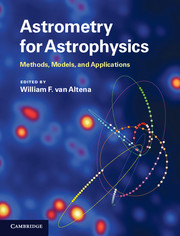Book contents
- Frontmatter
- Contents
- List of contributors
- List of acronyms
- Preface
- Part I Astrometry in the twenty-first century
- Part II Foundations of astrometry and celestial mechanics
- Part III Observing through the atmosphere
- Part IV From detected photons to the celestial sphere
- 13 Geometrical optics and astrometry
- 14 CCD imaging detectors
- 15 Using CCDs in the time-delay integration mode
- 16 Statistical astrometry
- 17 Analyzing poorly sampled images: HST imaging astrometry
- 18 Image deconvolution
- 19 From measures to celestial coordinates
- 20 Astrometric catalogs: concept, history, and necessity
- 21 Trigonometric parallaxes
- Part V Applications of astrometry to topics in astrophysics
- Index
- References
16 - Statistical astrometry
from Part IV - From detected photons to the celestial sphere
Published online by Cambridge University Press: 05 December 2012
- Frontmatter
- Contents
- List of contributors
- List of acronyms
- Preface
- Part I Astrometry in the twenty-first century
- Part II Foundations of astrometry and celestial mechanics
- Part III Observing through the atmosphere
- Part IV From detected photons to the celestial sphere
- 13 Geometrical optics and astrometry
- 14 CCD imaging detectors
- 15 Using CCDs in the time-delay integration mode
- 16 Statistical astrometry
- 17 Analyzing poorly sampled images: HST imaging astrometry
- 18 Image deconvolution
- 19 From measures to celestial coordinates
- 20 Astrometric catalogs: concept, history, and necessity
- 21 Trigonometric parallaxes
- Part V Applications of astrometry to topics in astrophysics
- Index
- References
Summary
Introduction
The term “statistical astrometry” refers to the inference of astrophysical quantities from samples (i.e. collections) of stars or other sources. Often the mean value of the astrophysical quantity or a description of its distribution is sought. The applications are numerous and include luminosity calibration, star-cluster membership determination, separating the Galaxy's structural components, detecting low-contrast substructure in the Galactic halo, etc. These studies become especially interesting now that astrometric catalogs are available with large numbers of parallaxes. However, there are a number of effects that can lead to errors in the inference of astrophysical quantities and thus complicate the interpretation of astrometric data. This chapter is focused on discussing these complicating effects with the aim of providing guidance on the optimal use of astrometric data in statistical studies.
Effects complicating the interpretation of astrometric data
The main effects that can complicate the interpretation of astrometric data for samples of objects are summarized below.
Completeness and selection effects
Any sample chosen from an astrometric catalog will suffer from incompleteness in the data and selection effects. Both issues are related to the properties of the astrometric survey and how the sample is chosen. In addition, they may depend on the location on the sky or the source properties. Hence, the chosen sample almost never represents the true distribution of sources in the astrophysical parameter space. Ignoring this fact leads to biased results in the scientific interpretation of the data.
- Type
- Chapter
- Information
- Astrometry for AstrophysicsMethods, Models, and Applications, pp. 242 - 256Publisher: Cambridge University PressPrint publication year: 2012
References
- 2
- Cited by



